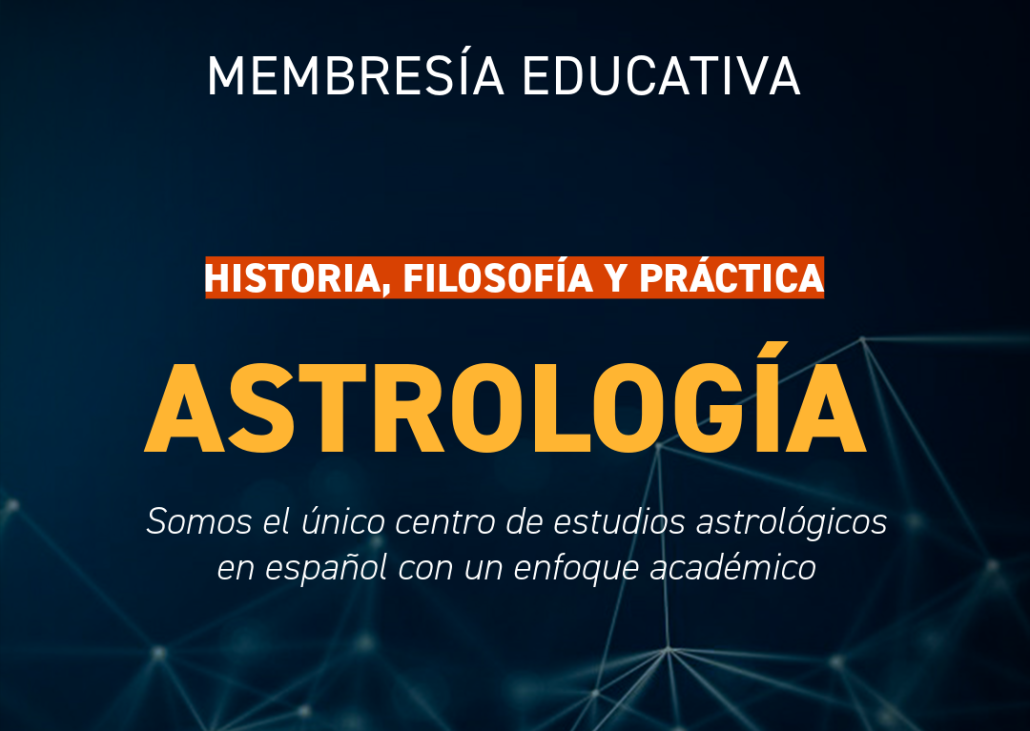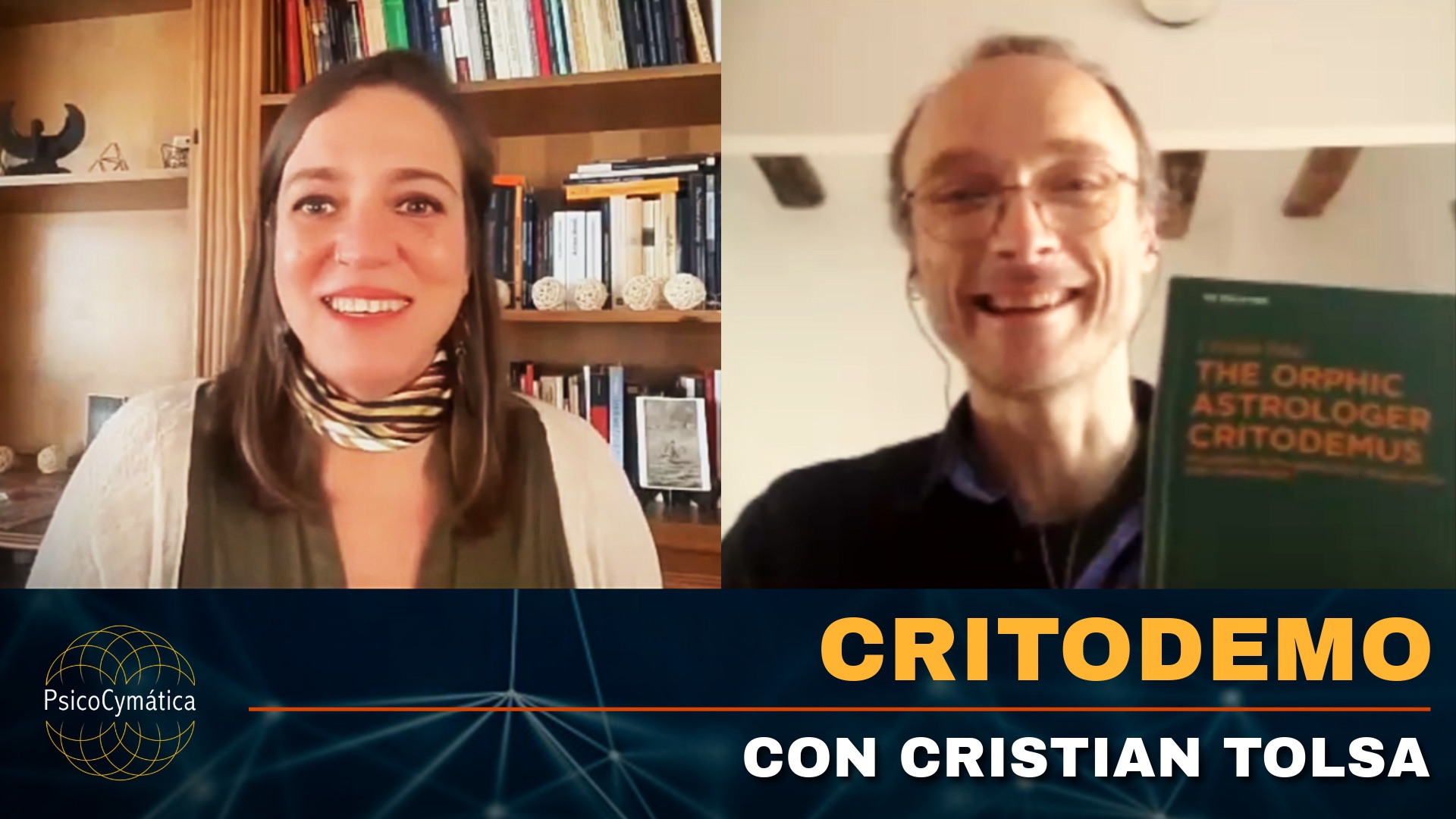El universo entero en un caracol de jardín
ENTREVISTA A BENJAMIN A. VIERLING
Benjamin A. Vierling es un artista visual nacido en 1974, establecido en California. En su obra, las influencias medievales y renacentistas cobran una vida absolutamente contemporánea y vibrante. Ha ilustrado tapas de álbumes de Joanna Newsom y Bill Fay, el soundtrack del videojuego Pentiment, libros como Thirteen Pathways of Occult Herbalism, y sus cuadros formaron parte de numerosas exhibiciones. En esta entrevista con PsicoCymática (que compartimos traducida y en inglés) habla del lugar de la simbología en su obra y de su proceso creativo.
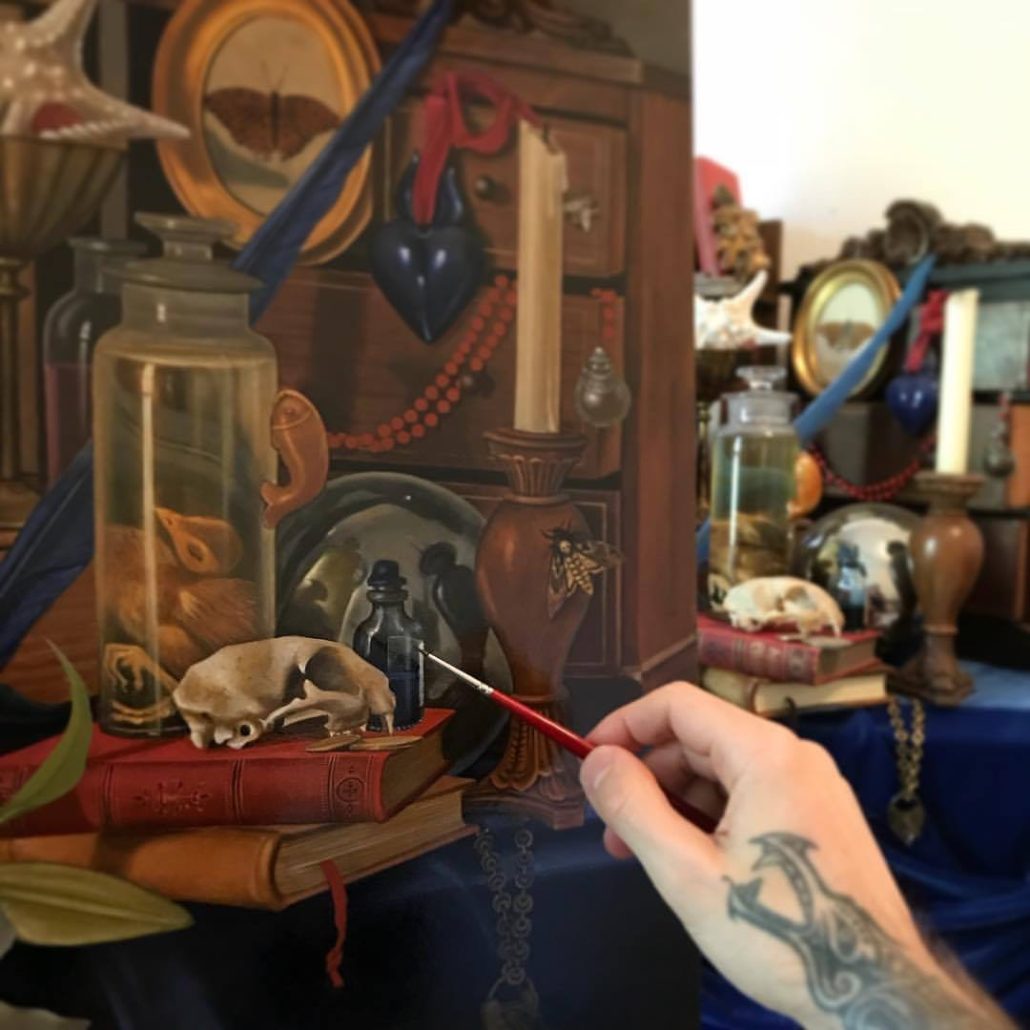 .
.
¿Qué tradiciones te resultan más inspiradoras? ¿Cuál es la fuente de los símbolos y los tópicos que nutren tu trabajo?
Mi fuente principal de inspiración es la estética de la tradición clásica tal como ha sido recuperada y reformulada a lo largo de los siglos, especialmente a partir de las transformaciones estilísticas que tuvieron lugar en Europa durante la Edad Media y el principio del Renacimiento. Durante el siglo XV se retomaron las proporciones dimensionales y las representaciones naturalistas del mundo antiguo, y se las fusionó con los planos dimensionales más chatos, los relatos alegóricos y los colores vivos característicos de la iconografía medieval. Aquella síntesis entre la imagen devocional y el objeto observado racionalmente engendró las imágenes tan evocativas que ahora asociamos con el período del Renacimiento.
Para mi trabajo han sido particularmente relevantes el naturalismo exuberante y las construcciones arquitectónicamente intrincadas de los pintores italianos, la intensidad espiritual de los españoles y los detalles minuciosos de los flamencos y alemanes.
Desde entonces, muchos movimientos artísticos han intentado abrevar de este manantial creativo, especialmente los nazarenos alemanes y sus equivalentes británicos, los prerrafaelitas, que surgieron unas décadas más tarde. Esta misma corriente de inspiración se manifestó una vez más en el movimiento de los pintores simbolistas que aparecieron en Europa y América durante el periodo de fin de siecle. En el siglo XX, estos principios fundamentales fueron adoptados de nuevo por parte de los realistas mágicos encabezados por el pintor austríaco Ernst Fuchs. A él se le atribuye haber perfeccionado una adaptación contemporánea de la técnica mixta de témpera de huevo y óleo inspirada en el Renacimiento. Estudié esta técnica en Austria hace unos años y es la que utilizo como metodología básica a la hora de componer. El resurgimiento de la apreciación de estos valores estéticos continúa floreciendo en el siglo XXI, y hoy en día hay muchos pintores e ilustradores excepcionales, varios de ellos a quienes tengo el orgullo de considerar pares, que están siguiendo esta tradición.
Con respecto a la composición visual, suelo hacer referencia a temas clásicos y figuras arquetípicas presentes a lo largo de toda la historia. Muchos de esos temas transmiten relatos inmemoriales que se pueden encontrar en un sinfín de mitos y leyendas de distintos lugares del mundo. Hay determinados tópicos, tales como el memento mori, que se repiten especialmente a través de los siglos, y ese tipo de estructuras imperecederas son las que intento elaborar. En general, dichos temas hacen referencia a cuestiones fundamentales que son inherentes a la experiencia humana, desde el origen de la vida hasta su inevitable final y el posterior renacer.
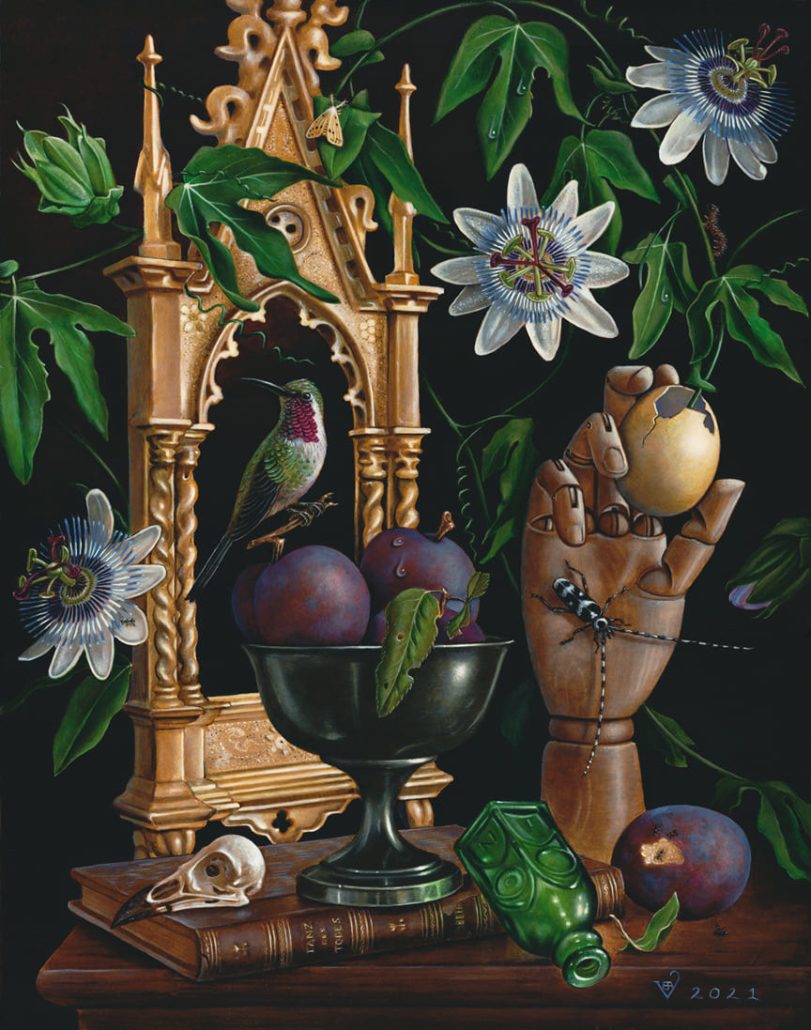 Still Life with Passiflora (2021)
Still Life with Passiflora (2021)
¿Consideras que los símbolos presentes en obras de arte tienen el poder de provocar transformaciones en la visión del artista y del espectador?
Sin duda la experiencia esencial de crear puede ser una experiencia catártica. Al confeccionar una imagen, en el proceso de establecer relaciones entre colores y formas, es posible analizar y elaborar desafíos existenciales. A medida que estas relaciones se exploran y se esclarecen, uno accede a una comprensión mayor, así se trate de una obra abstracta o figurativa, con significado literal o alegórico. Por ende, en la contemplación de la imagen, el Espectador puede meditar acerca de estas relaciones. En este sentido una imagen simbólica efectivamente puede facilitar una expansión de la conciencia.
En cuanto al material simbólico, aquello que evocan los símbolos específicos, tanto para el artista como para el espectador, entra en una amplia zona problemática. Los símbolos pueden significar cosas diferentes para distintas personas en momentos históricos distintos. Un búho, por ejemplo, representa una sagacidad benevolente, Sabiduría, en determinadas culturas, y en otras es un mal augurio, un presagio de Muerte. Aun teniendo en consideración esta diversidad de interpretaciones, en última instancia el artista no tiene demasiado control sobre cómo se percibe la imagen al ser contemplada a través del lente de la historia, o por parte de otras culturas. En cierta medida, el acto de crear es un acto liberador: la Creación cobra una identidad que es más que la suma de sus partes, y una vez que ha sido lanzada al mundo se vuelve autónoma. Hay que permitirle al arte que exista en sus propios términos.
No obstante, el artista puede pulir sus propias intenciones en el proceso creativo, impregnándolo con sus experiencias subjetivas mediante una inversión de tiempo y trabajo. Si consideramos el proceso creativo como un viaje, no siempre resulta claro cuál es el destino. En definitiva, el proceso tiende un puente entre lo conocido y lo desconocido, abre un camino hacia el descubrimiento.
Vivimos en una época única en la que las creaciones de todos los tiempos están al alcance para que todo el mundo pueda apreciarlas. De hecho, el aluvión de imágenes puede resultar abrumador. En este momento histórico único, el rol del artista plástico es a la vez el del alquimista y el del pastor: debe hacer una síntesis entre miles de influencias y guiar al espectador curioso a descansar en la visión concentrada de una imagen estática.
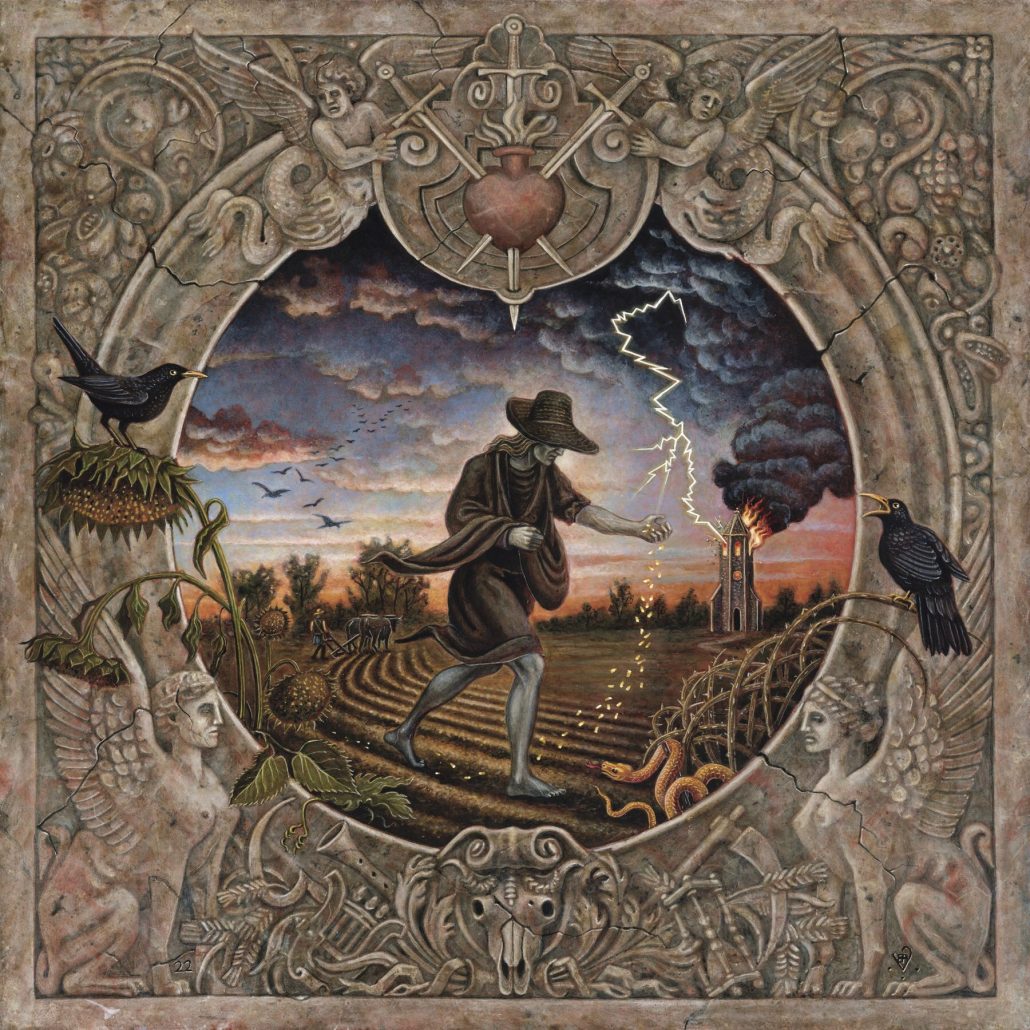 Black Terrain (2022)
Black Terrain (2022)
Portada del álbum musical de Forlesen
Dijiste en otra entrevista que “La representación hiperrealista y meticulosa de la flora y la fauna expresa la profunda belleza del macrocosmos a través de la adoración del microcosmos”. ¿Qué relación percibes entre estos dos planos, el macro y el microcosmos?
La dualidad es un fenómeno peculiar porque ambos polos dependen del otro para definirse. Se trata de una relación simbiótica. Y esto aplica tanto a la metafísica como a la teoría del color. En cuanto al micro y el macrocosmos, este paradigma es lo que se expresa en el principio “como es arriba, es abajo”, lo cual significa que complejas verdades metafísicas pueden manifestarse también en la realidad material más básica. En definitiva, es la idea que considera que lo divino y lo mundano son dos caras de un mismo fenómeno.
Dicho de manera más sencilla, el universo entero está contenido en la forma perfecta de un caracol de jardín. Cuando el artista reproduce la espiral sobre el caparazón del Helix aspersa, toda la estructura del cosmos queda representada. Rumiando los infinitos detalles del mundo natural se puede alcanzar una conciencia cósmica. Todos estos son principios básicos de la meditación, pero en este caso es el mismo proceso creativo el que constituye la praxis.
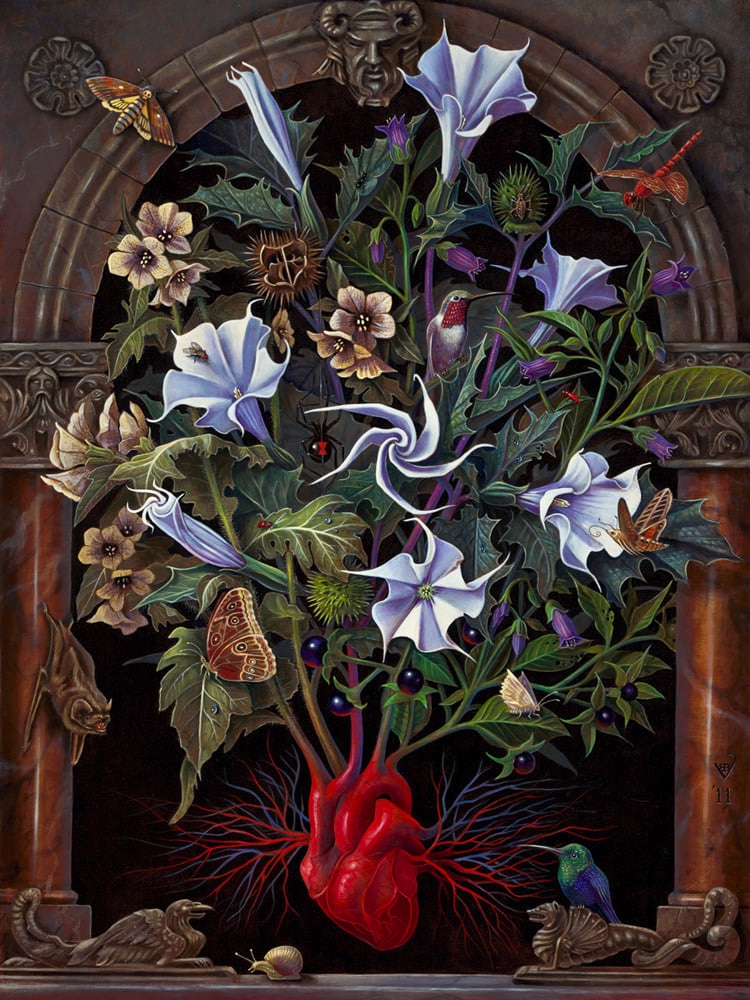 Sacred Heart (2011)
Sacred Heart (2011)
Por favor cuéntanos acerca de tu proceso creativo. ¿De qué se trata la creación y la creatividad en tu experiencia particular?
El viaje creativo suele ser tortuoso y laberíntico. Hay tantas variables en el camino y cada proyecto es tan único que es difícil identificar una ruta con precisión de fórmula. Pero habiendo aclarado esto, puedo enumerar algunas técnicas de procedimiento en las que me apoyo para llevar a cabo un proyecto, que varían según de qué se trate, los materiales empleados y la utilidad final de la imagen.
Como gran parte de mi trabajo está hecho por encargo, la concepción de cualquier proyecto incluye identificar las necesidades particulares de quien lo haya encargado, lo cual se logra a través de conversaciones muy profundas acerca del proyecto. Una vez que se establece el tema y el contexto, en general procedo a hacer un borrador conceptual de la imagen. Si la tarea es ilustrativa, esta bajada a lo concreto es de gran importancia, ya sea que se trate de un cuadro para una exposición, la portada de un libro o un álbum, un póster, la impresión de una ilustración, etcétera. En algunos casos hay mucha gente involucrada en el desarrollo. En la elaboración de la portada de un álbum, por ejemplo, participan los músicos, el sello discográfico, el director de arte y el diseñador gráfico. Para crear una imagen memorable, todos estos hilos de influencias deben ser entretejidos con cuidado, y eso es lo que intento hacer desde el momento en que trazo las primeras líneas de lápiz en el papel hasta la instancia de fotografiar el trabajo terminado.
Considero que mi función creativa consiste, en última instancia, en ser un canal para todo un espectro de influencias: por un lado el legado de la historia del arte, la tradición del oficio de crear imágenes a la que intento contribuir; por otro lado la visión particular de quien solicita el trabajo, que reconozco que suele ser la fuerza que guía el proyecto; y por último, la manifestación de la fuerza creativa en sí misma, que a menudo aparece de forma impredecible y surge desde un lugar que está más allá de lo consciente.
Which traditions inspire you most? Where do you get the symbols and themes that nurture your artwork from?
I am primarily inspired by the aesthetics of the classical tradition, as it has been resurrected and reinvented through the ages, with particular emphasis on the stylistic transformations that occurred in Europe during the late Middle Ages and early Renaissance. During the 15th century, the dimensional proportions and naturalistic renderings of the ancient world were resurrected and melded with the flattened dimensional planes, allegorical narratives, and bold colors of medieval iconography. This synthesis of the devotional image with the rationally viewed subject gave birth to the richly evocative images that we now associate with the Renaissance period. Particularly relevant to my work is the lush naturalism and architecturally intricate constructions of the Italian painters, the spiritual intensity of the Spanish painters, and the painstakingly rendered details of the Flemish & German painters.
Since that time, various artistic movements have endeavored to tap into this creative wellspring, specifically the german Nazarene painters in the mid 19th century, and their British counterparts, the Pre-Raphaelites, who blossomed some decades later. This same inspirational current manifested again in the Symbolist artistic movements that flourished throughout Europe and in the Americas during the fin de sicle period. In the 20th Century, these fundamental principles were again embraced by the Magic Realists, spearheaded by the Austrian painter, Ernst Fuchs. Fuchs is attributed with perfecting a contemporary adaptation of the renaissance-inspired, egg tempera and oil ‘misch’ technique. It is this painting technique that I studied in Austria some years ago, and use as a foundational methodology for constructing my works. A resurgence of appreciation of these aesthetic values has continued to flourish in the 21st century, and there are many exceptional painters and illustrators today, many of whom I am proud to call peers, who are carrying on this tradition.
In visual composition, I tend to reference classical themes and archetypal figures that repeat themselves throughout history. Many of these subjects convey timeless narratives that can be found in myriad of regional myths and legends. Certain motifs, such as the Memento Mori, are specifically reiterated through the centuries, and it is these timeless structures on which I endeavor to elaborate. These themes tend to address fundamental questions inherent in the human experience, from the inception of life, to the inevitable end, and ultimate rebirth.
.
Do you believe symbols in art have the power to trigger a transformation in the artist and the observer’s understanding?
The fundamental experience of creating can absolutely be a cathartic one. Existential challenges can be examined and worked out through the crafting of an image, the process is one of establishing relationships between colors and shapes. As these relationships are explored and clarified, greater understanding can be facilitated. The
visual manifestations may be abstract or figurative, literal or allegorical. By extension then, the Viewer is able to meditate on these conceptual relationships through contemplation of the image. In this way, a symbolic image can indeed facilitate the expansion of awareness.
Regarding symbolic content specifically, there is a large grey area in terms of what specific symbols may indicate for both the artist and the viewer. Different symbols may mean different things to different people at different times. For instance, an Owl in one culture may represent sagacious benevolence, Wisdom, yet in another culture it may be an ill omen, a harbinger of Death. Even when taking these diverse interpretations into account, the artist ultimately has little control over how the image may be perceived when viewed through the lens of history, or by other cultures. To a certain extent, the act of creating is a liberating one, the Creation takes on an identity greater than the sum of it’s parts, existing autonomously once it has been freed into the world. Art has to be permitted to exist on it’s own terms.
The artist can nevertheless refine their own intentions through the process of creation, imbuing it with their own subjective experiences by way of an investment of time and labor. If we regard that creative process as a journey, it’s not always clear what the destination is. Ultimately, this process is a bridging between the known and the unknown, a path towards discovery. We live in a unique time, when all creations from all times are readily available for everyone to appreciate. This flood of imagery can in fact be overwhelming. In this unique epoch, the visual artist’s role is that of both alchemist and shepherd; synthesizing a myriad of influences, and leading the inquisitive viewer to rest in the focused vision of a static image.
.
You once said in another interview that “The meticulous hyper-realistic rendering of flora and fauna expresses the profound beauty of the macrocosm through adoration of the microcosm”. Which is the relation you perceive between these two —macro and microcosm?
Duality is a curious phenomenon, because both sides depend on the other for the definition of their own identity. It is a symbiotic relationship. This is true whether we are discussing metaphysics, or color theory. In the case of the macrocosm and the microcosm, this paradigm is a manifestation of the alchemical idiom, ‘As Above, So Below’, – which simply means that complex metaphysical truths may be made manifest through basic material reality. This is ultimately the idea that the divine and the mundane are two faces of the same phenomenon. Put more simply then, the universe is contained in the perfect form of a garden snail. When the artist renders the spiral on the shell of a helix aspersa, the entire structure of the cosmos is indicated. By ruminating on the infinite details of the natural world, cosmic awareness may be attained. These are all basic principles of meditation, but in this case, it is the creative process itself that is the
praxis.
.
Please tell us about your creative process. What is creation and creativity in your experience?
The creative journey is often a circuitous and labyrinthian one. There are so many variables on the path, its difficult to identify the route with formulaic accuracy, as every project is ultimately unique. With that established, there are nevertheless procedural techniques that I tend to rely on in order to bring a project to completion, which fluctuate depending on the thematic content, the media used, and the ultimate application of the image. Since much of my work is commissioned, the inception of any project always involves identifying the unique needs of the patron, which is accomplished through in-depth discussions about the project. Once the theme and context is established, I typically proceed by drafting a conceptual sketch for the image. If the task is an illustrative one, the physical application is of great significance, whether it is a painting for exhibition, a book or album cover, a poster, a print illustration, and so on. In some cases, there may be multiple people involved in this stage of development. An album cover composition for instance, may involve input from the musicians, the record label, the art-director, and the graphic designer. All of these threads of influence need to be tactfully woven together with the purpose of creating a memorable image, and this is what I endeavor to do; from the time that the first pencil lines are established on paper, to the photographing of the final original work.
I view my creative role as ultimately being a conduit for a spectrum of influences: There is the legacy of art history, the tradition of image-craft that I endeavor to elaborate on and to contribute to. There is the unique vision of the individual patron, which I acknowledge as often being the guiding force behind a project. Finally, there is the manifestation of the creative force itself, which often comes unexpectedly, and from beyond the conscious mind.
➤ Entrevista realizada y traducida por Florencia Parodi | Febrero 2023
✧ ✧ ✧
Sitio y redes de Benjamin A. Vierling
bvierling.com
Ig: @ba_vierling

